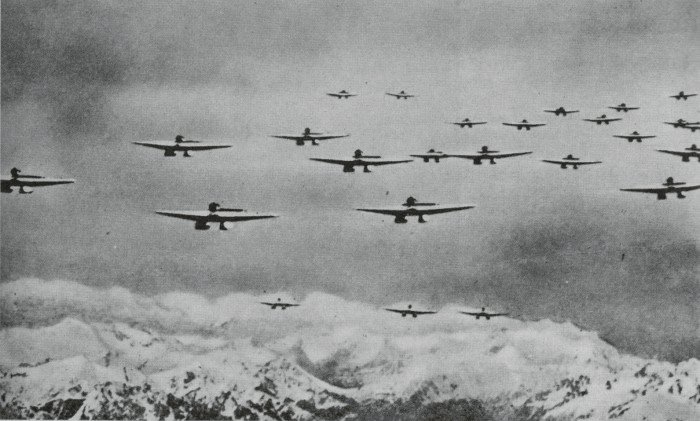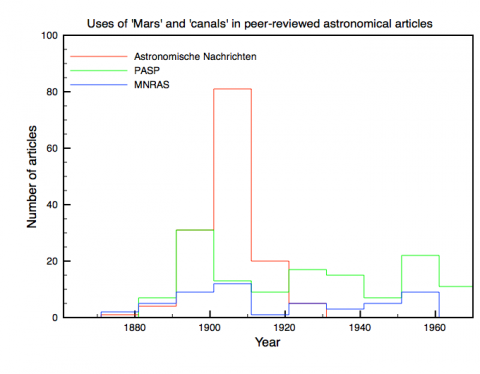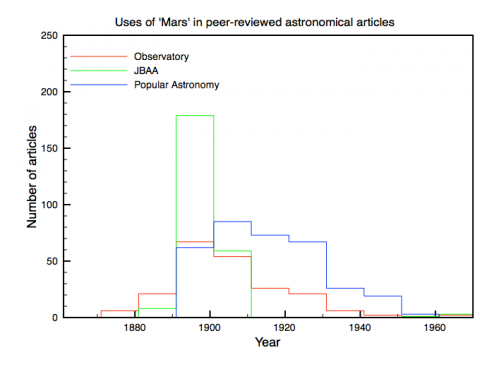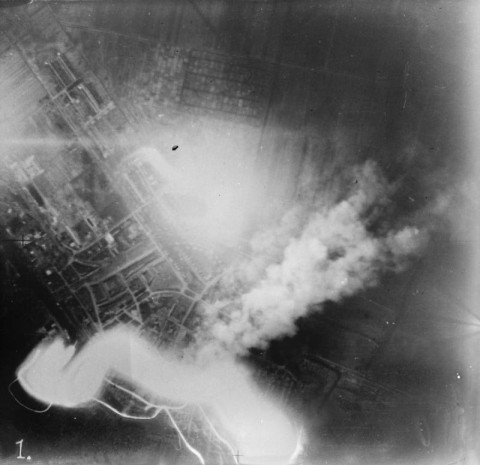This photograph purportedly shows a squadron of Italian Savoia-Marchetti S.55X flying boats over the Alps on 1 July 1933, during the second and last of the long-distance formation flights led by the Fascist air minister, Italo Balbo (hence 'balbo', briefly in vogue to describe a large formation of aircraft), Rome to Chicago and back. These flights were (and were intended to be) a powerful and spectacular display the reach and power of Italian aviation, repeated and enhanced through images such as this, and therefore a prime example of what I call aerial theatre.
...continue reading
Words
More on ‘the Few’
A few years ago I argued that 'the Few' in Winston Churchill's famous speech of 20 August 1940 didn't refer to the pilots of Fighter Command, as is almost universally assumed, but instead referred to all British airmen, or even perhaps specifically the airmen of Bomber Command, since he spends about two paragraphs talking about bombers and about half a sentence talking about fighters. I still think that's pretty clearly the case (even if not everyone was convinced); and it's clear why he would have done so -- as he himself might have said, wars are not won by defensive victories. But I thought it was worth taking another look at the question of which people (or at least newspapers) at the time thought 'the Few' referred to, particularly since the British Newspaper Archive opened a few months after I wrote that post.
So I did a BNA search for the period 20 to 27 August 1940 (the day of the speech itself, to catch the evening newspapers, plus a week, to catch the weeklies) in articles only for the words 'Churchill' and 'few'. To be thorough, though, I really should have looked at all discussions of Churchill's speech, since some might have paraphrased that part of it or just not mentioned the word 'few'. I don't have time for that here, but focusing on the Few reveals just how few (ahem) newspapers thought that this phrase was worthy of comment. My search found just eight articles, once all irrelevant hits on 'few' were discarded.
...continue reading
Flitting, 1950
This cartoon appeared in Flight in 1913.1 It's entitled 'In 1950' with the caption 'Flitting -- by the light of the Easter moon'.
Now, 'flitting' is a term used in Scotland and the north of England to mean moving house. It is, or at least was, a practice which happened much more often there than in the south. In fact, it was something of an annual tradition in Scotland, with 25 May in particular being Flitting Day. The Motherwell Times described the scene in an 1898 leading article:
The week that has about gone provides at least one field day in the year for a considerable proportion of our population. Some people must flit every year, and they are no sooner installed in their new diggings than they begin to cast their vision about in order to select the battle-ground of their next upheaval. Now may be seen the central figure of the show, the commander-in-chief of the whole operations, with whitewash in her hair, fire in her eye, and anathemas on her lips, careering wildly about, seeking for some devoted one which to explode her righteous indignation. The poor titular head of the house is altogether a secondary and quite unimportant individual, and if ever he has been prone to at any time think of himself as somebody in particular, it is about now that he gets the starch taken out, and he is made to realize that he is only small potatoes after all.2
There's an obvious gender aspect to this, and a less obvious class one too -- the poor were much more likely to rent their homes rather than own them, and so were much more likely to move about. This is evident in Flight's cartoon, too: although the flitting in 1950 is being done with the aid of a (not particularly realistic) aeroplane, it has patches on its wings and the passengers perched on the back are of humble appearance. What's more, it's not just any old flitting that is being done, but moonlight flitting: i.e. secretly moving house in the dead of night, in order to escape creditors and landlords.
What is the point of this cartoon? It doesn't seem to be any sort of topical reference, and it was published a couple of months before Flitting Day. Obviously it's not meant to be taken particularly seriously. There's probably a play on the other meaning of 'flitting', in the sense of the swift motion of small animals, particularly flying ones like birds and bats. But there is also a glance at Britain's airminded future, even if in a very lighthearted way, at the idea that aviation would become an integral part of British society, that Britons would naturally and instinctively turn to the skies, that even the poor would have access to aircraft. It's also perhaps a little satirical though, because -- at least in this respect -- becoming airminded has not fundamentally altered British society. People are still poor, still evade their debts, and still flit by moonlight; all the coming of flight has done is to change their mode of transportation.
Divers alarums
I often toss the nouns scare and panic around. One of my articles is titled 'The air panic of 1935', another is subtitled 'airmindedness and the Australian mystery aeroplane scare of 1918'. Sometimes I use them to mean the same thing: in the former article, about the press agitation for RAF expansion in response to the aerial rearmament of Germany, I even refer to 'a panic or scare'.1 I'm not alone in this: for example, an article by Matthew Seligmann is entitled 'Intelligence information and the 1909 naval scare: the secret foundations of a public panic', and uses the phrases '1909 scare' and '1909 panic' twice each.2
Despite this, I do tend to think of scare and panic as having slightly, and usefully, different meanings. Both are about fear, obviously, but the difference lies in the intensity of the fear and hence the response to it. A scare seems less intense than a panic: a scare is closer to being startled; panic is more akin to terror. And we can speak of a panic attack or a panic reaction: a surge of adrenalin, the impulse to flee, losing control of mind and body. But a startle reflex is more like just jumping out of your skin when being surprised by something unexpected. After a moment you are back to normal; there are no significant or longterm effects.
...continue reading
Volcanic warfare — II
Quite some time ago I promised to write more about J. M. Spaight's Volcano Island (published in 1943 but written late in 1942). I probably should do that at some point. Such as now.
Here I want to look at what he has to say about area bombing. He quite unapologetically uses this phrase, even calling one section 'The legitimacy of area bombing'.1 Given the opprobrium which now attaches to the term, it is a little startling to see it used in a defence of British bombing policy. It does seems to have been used more descriptively during the war, at least at first. The very earliest use I've been able to find was in the British press in December 1940, and referred to the resumption of German 'Blitz' tactics:
The return to mass raiding was not carried out on anything like the 'Coventrating' manner -- there was no attempt at area bombing of the different London districts, all of which had their share at varying periods of the night.2
However, 'area bombing' here apparently refers not to merely indiscriminate bombing (which the Gloucestershire Echo's headline asserts the Germans have admitted to). Instead it is concentrated in both time and space, as at Coventry (hence 'Coventration'), which actually describes what Bomber Command later tried to (and often did) achieve quite well. This might be an isolated example; the term doesn't seem to start cropping up again until late 1942, just about when Spaight was writing: in September the Devon and Exeter Gazette noted that 'The R.A.F. will continue its "area bombing" by night, while the famous Flying Fortresses will take up the attack by day with precision bombing'.3 By March 1943, Richard Stokes MP could ask in the House of Commons if 'instructions have been given to British airmen to engage in area bombing rather than limit their attention to purely military targets?' (only to be told by Sir Archibald Sinclair that 'The targets of Bomber Command are always military, but night bombing of military objectives necessarily involves bombing the area in which they are situated').4
...continue reading
Friday, 28 March 1913
Judging from the report in the Western Gazette, Captain Faber, Conservative MP for Andover, evidently is not convinced by the letter he received from the Prime Minister downplaying the mystery airship visits, for in a speech to his constituents at Weyhill in Hampshire he invoked them as a counterargument to the War Minister's downplaying of airships in general (p. 11; above):
Turning to the question of airships, Captain Faber said that Germany and France were spending brains and millions of money on these ships, but whilst this was so, our incurable optimist said airships were of no use to us. Had we in this country a monopoly of brains? Were the airships lately over Sheerness and Grimsby of no use?
Faber ridiculed Colonel Seely's suggestion that 'he had a gun to defend these shores from airships':
Was he going to have a gun every half-mile all round England, Scotland, and Wales, ready loaded, with a man always there to shoot? For it must be remembered that an airship travelled at the rate of sixty miles an hour.
He claimed that German experiments had anyway shown that 'three hits from below made but little difference [...] If the wound was inflicted at the top of the airship, it would be different and dangerous'. As for Seely's idea that 'airships were no good at night, because they could not see',
Had he forgotten the bright lights of London and Liverpool, which were visible for many miles from above the earth, and the frightful consternation that would be caused by explosives dropped at night over any big town?
Faber also has some interesting information about one 'foreign airship' (presumably German, though why he doesn't say so is unclear) in particular, contained 'in a letter in his possession from an absolutely reliable source -- from a passenger in this very airship'. It 'covered 1,600 miles without a break in twenty-nine hours' just 'the other day', and is 'about half the length of the Mauretania, had a crew of twenty-eight officers and men, and cooking, dining, and sleeping rooms'. It also has advanced camouflage and navigational technology:
They could cover themselves at any moment with vapour cloud to stop dectection [sic]; they were always surrounded by prepared covering that prevent reflection, so that they could not be photographed; they carried maps that were unrolled by the steersman, showing all the country they travelled over. Goetz, the man who invented the Goetz lens, had contrived a patent which, with mirrors pointing downwards from either end, would record most accurately and minutely the survey of the country over which they passed. There were thirty-eight of these airships ready, and thirty on order. He gave these few details concerning foreign airships to open the eyes of the country to the menacing danger threatening us. (Cheers.)
The Gazette also carries a notice about the wreck of the Ersatz Z I over a week ago, noting that it was 'the "fly-by-night" monster airship which is supposed to have recently visited England and created a scare' (p. 5).
The word 'scareship' appears in an article in the Manchester Courier attacking complacency on the airship issue on the part of Liberals as a generic term rather than one referring to phantom airships specifically. The Radical press is accused of having
substituted the word scareship for airship, they regarded all our accurate information on airships capable of discharging tons of explosives as a figment of the imagination.
The Government is described as 'until recently, case-hardened sceptics to whom "airships" and "scareship" are synonymous terms', while Seely's bizarre idea about airships not being able to see anything if they can't be seen is described as 'This is precisely the sort of reason which appeals irresistibly to the people who confound an airship with a "scareship," but it is inexcusable levity in a Minister of War' (p. 7). The Courier's larger argument is that
Aerial navigation has passed from the realms of imagination. Germany, by her splendid enterprise, has so developed the airship that the countries of the world must alter their whole methods of defence. The war of the future will be fought in the air. Diplomacy or bartering between nations succeeds or fails in proportion to the defensive forces possessed by those nations. And the coming of the airship affects no other country so vitally as Great Britain.
What is needed is 'an Aerial Budget, with proper and adequate provision for our aerial needs', and what is needed for that is 'a great public agitation', and so the Courier calls upon 'the Aerial League, the Navy League, and those other bodies interested to press forward the campaign'.
The canals of Mars, 1861-1970 — III
So, to wrap up this accidental series. To check whether professional astronomical journals displayed the same patterns in discussing 'Mars' and 'canals' as the more popular/amateur ones I again looked at the peak decade 1891-1900, this time selecting only the more serious, respected journals. However, because of the French problem I had to exclude L'Astronomie and Ciel et Terre (the former was apparently more popular anyway). So for my top three I ended up with Astronomische Nachrichten, Publications of the Astronomical Society of the Pacific (PASP) and Monthly Notices of the Royal Astronomical Society (MNRAS). Astronomische Nachrichten ('astronomical notes') was the leading astronomical journal of the 19th century, founded 1821. It published articles in a number of languages including English. Fulltext Service seems to be multilingual, as it picks up the German (at least) equivalents of Mars/Martian and canal/canals. That doesn't help with the French problem, but that will only affect a small minority of Astronomische Nachrichten's articles. The Astronomical Society of the Pacific was founded in California as a joint amateur-professional organisation. Its PASP is now a very highly regarded journal, although I must admit I don't know if this was always the case. MNRAS is the journal of the Royal Astronomical Society in Britain. It also happens to be where my solitary peer-reviewed astronomy article was published (and when I say 'my', I think approximately 1 sentence relates to research I actually undertook), but even so it really is a highly-respected journal.
...continue reading
The canals of Mars, 1861-1970 — II
In my post about the lingering scientific interest in the Martian canals hypothesis after 1909, I said that there was a problem with journal coverage. What do I mean by this? Have a look:
This is a repeat of the first plot in the previous post, showing the number of articles published in peer-reviewed astronomical journals mentioning 'Mars' and 'canals' between 1861 and 1970, only this time for each of three journals: Observatory, Journal of the British Astronomical Association, and Popular Astronomy. I chose these three because they were the journals which had the most such articles, both over the entire period and in the peak decade of the 1890s.
...continue reading
The canals of Mars, 1861-1970 — I
In a recent, hmm, let's call it a discussion resulting from an old post I wrote about the US Air Force's one-time interesting in mapping Mars, I tried to assess how scientific interest in the Martian canals hypothesis lingered after the early 20th century, and said I would run up some figures to illustrate the data. So here they are.
My source is the ADSLabs Fulltext Service. ADS is the Astrophysical Data System, an online database of articles published in astronomy and physics journals. Which doesn't sound so amazing these days, but it was in 1994 when I first used it! (More on its history here.) The interface has changed remarkably little since then, but it is still free and very comprehensive. While it is primarily an abstract service, fulltext is available for many older articles -- but only as non-searchable images. Moreover, not all articles have abstracts. However, the text of articles from most of the major journals have been OCRed into a parallel database, the Fulltext Service. Like the classic ADS Abstract Service, this was not designed with historians in mind, but it's still quite useful.
...continue reading
The first blockbuster
One factlet I've enjoyed dropping on the heads of students is the origin of the word 'blockbuster'. Now it is widely understood to mean a hugely successful movie (as well as a once-highly successful video rental chain -- remember those?). It has even been claimed that this is the original sense of the word: supposedly, in the 1920s a blockbuster was 'a movie whose long line of customers could not be contained on a single city block'. But with Google Books and online newspaper archives it's easy to disprove this etymology: blockbuster does not appear before 1942 and then it referred to a bomb which was so big it could destroy a whole city block.
...continue reading






